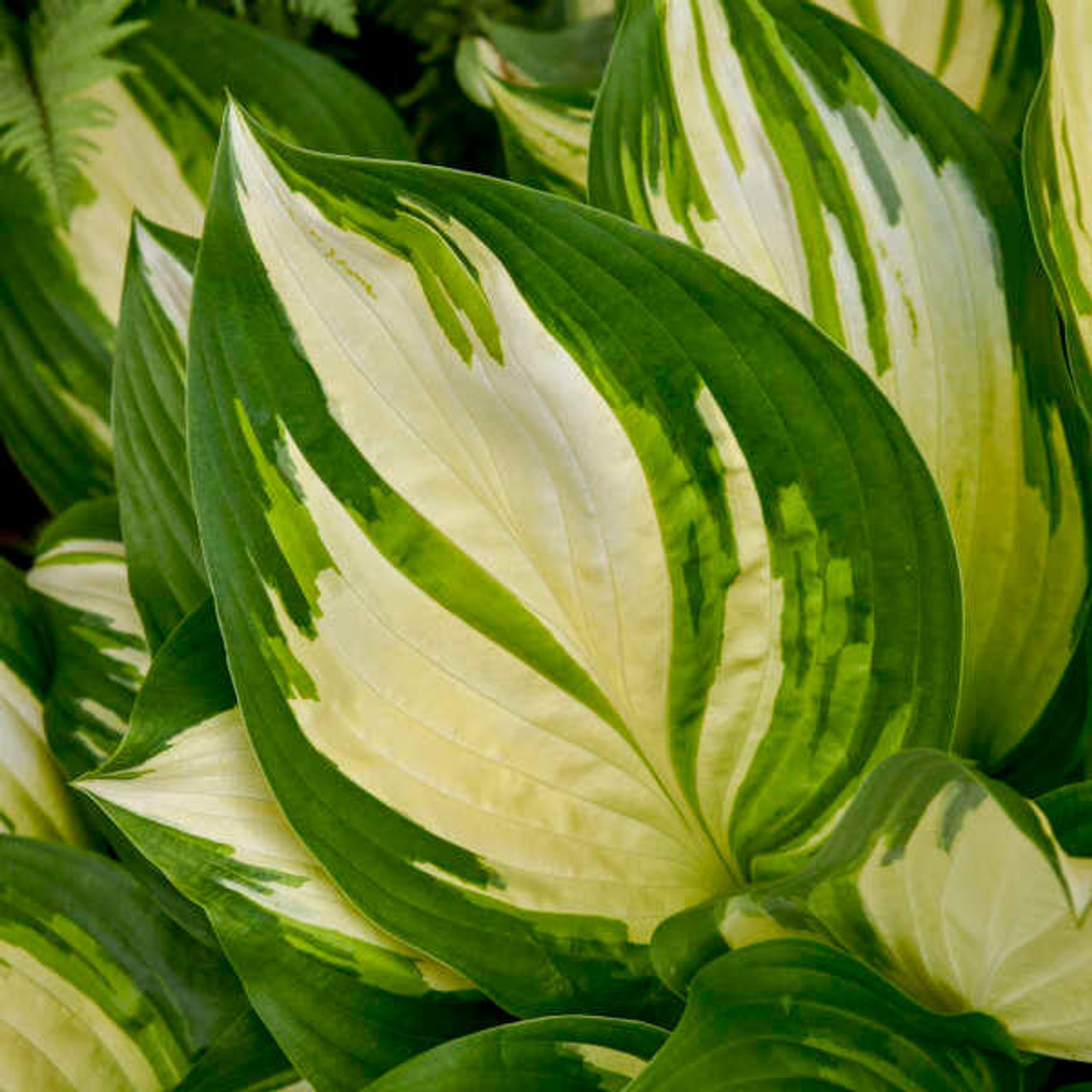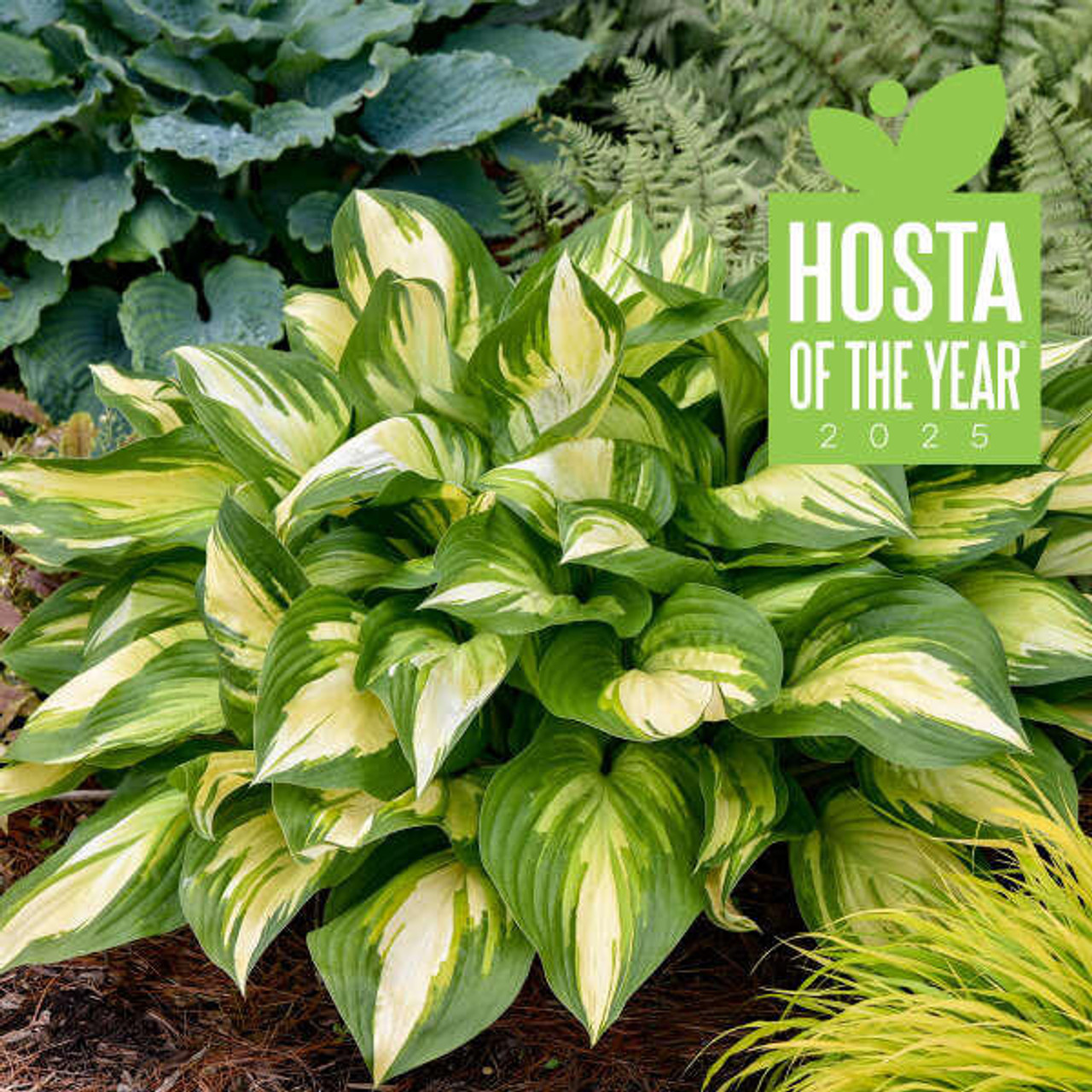Product Description
Hosta 'Miss America' PP32068 CPBRAF (20)ct Flat
Proven Winners® SHADOWLAND® Collection
A majestic, variegated large hosta that will capture the hearts of any gardener who showcases it in their garden. Medium green, heart-shaped leaves have white centers and light green intermediate streaking between the center and margin. The contrast between the margin and the center is dramatic and refined. Near white, tubular flowers have a lavender pattern in the center of the petals are borne on thick, upright, tall stems. The flowers were notably the most attractive we've seen on a hosta.
Hostas are exceedingly popular perennials in today's gardens due to their versatility in the landscape. Their subtle colors, tall flower scapes, and broad, coarse leaves fill a niche in garden designs that few other plants can achieve. Their large leaves provide excellent coverage for dying bulb foliage. Hostas also grow well in city environments where the air may be polluted by car exhaust, etc.
Hostas grow best in moist, well-drained, highly organic soils with a pH between 5.5 and 7.5. Sandy loam is better than clay because it provides more aeration for the roots. High-filtered or dappled sunlight is necessary for clean, healthy growth. Morning sun is tolerable and will help to intensify the leaf colors, but hot afternoon sun is usually deadly to hostas. They are most at home in shady, woodland settings and often work well as specimen or edging plants.
Especially in northern zones, hostas should be mulched with a layer of finely shredded organic material to prevent heaving in the winter. Mulch is beneficial because it retains moisture around the plant's roots, but it is also the ideal place for slugs to hide. Watch for holes in the center of the leaves. If they are present, so are slugs. Applying a slug bait in early spring when new shoots are beginning to emerge will help to reduce the slug population. After a few years when plants are firmly established, the mulch can be removed completely, which should eliminate the slug problem altogether. Also be sure to clean all hosta foliage out of the garden in early winter after the plants have gone dormant. By doing so, you will be ridding the area of the eggs of slugs and other leaf-eating insects.
2025 Proven Winners National Hosta of the Year®
Height: 19.0 Inches
Spread: 55.0 Inches
Scape Height: 55.0-61.0 Inches
Hardiness Zones: 3,4,5,6,7,8,9
Flower Color: Purple shades
Foliage Color: Green shades, Variegated
Part Shade (4-6 hrs. Direct Sun) - Full Shade (< 4 hrs. Direct Sun)
Average to Consistent Water Needs
Average to Fertile Soil Quality
Bloomtime: Early Summer - Midsummer
Attracts Hummingbirds
Growth Rate: Rapid
Border Plant, Container, Cut Foliage, Easy To Grow, Attractive Foliage, Mass Planting
Hosta 'Miss America' is a truly majestic hosta that lives up to its grand name, offering a stunning combination of impressive size, elegant foliage, and towering flower scapes. Here is what makes it special:
What Makes Hosta 'Miss America' Special
- Large Size: 'Miss America' is a large hosta, forming a substantial mound of foliage that can reach 19 inches tall and 55 inches wide. This makes it a standout in any shade garden.
- Striking Variegation: The heart-shaped leaves are a vibrant green with a wide, creamy white center and lighter green streaks between the center and margin. This creates a beautiful contrast and adds a touch of elegance.
- Towering Flower Scapes: In mid-summer, it sends up incredibly tall flower scapes that can reach up to 5 feet! These scapes are adorned with pale lavender to white, tubular flowers that have a subtle lavender pattern in the center of the petals.
- Vigorous Growth: 'Miss America' is known for its vigorous growth and ability to quickly form a large, impressive clump.
- Slug Resistance: The thick leaves offer some resistance to slug damage, which is a bonus for gardeners in areas with slug pressure.
Description and Details
- Common Name: Miss America Hosta
- Botanical Name: Hosta 'Miss America'
- Mature Size: 19 inches tall, 55 inches wide
- Foliage: Green with a creamy white center and lighter green streaks, heart-shaped
- Flowers: Pale lavender to white with a lavender pattern, blooming in mid-summer on tall scapes
- Growth Habit: Mounding
- Hardiness Zones: 3-9
- Light: Part shade to shade
- Soil: Moist, well-drained, rich in organic matter
- Water: Water regularly, especially during dry periods
Landscaping Design Tips
- Specimen Plant: Its impressive size and striking foliage make it an excellent specimen plant, where it can be the focal point of a garden bed.
- Back of the Border: It is also well-suited for the back of borders, where it can provide a backdrop for shorter plants.
- Shade Gardens: It thrives in shade gardens, where its bold foliage and tall flower scapes can create a dramatic effect.
- Woodland Gardens: It is a natural choice for woodland gardens, where it can mingle with other shade-loving plants.
- Companion Plants: Consider pairing them with other shade-loving plants with contrasting colors and textures, such as:
- Ferns
- Astilbes
- Heucheras
- Coral Bells (Heuchera)
Planting and Care
- Planting:
- Choose a shady location with moist, well-drained soil.
- Plant in spring or fall.
- Space plants according to their mature size (about 4-5 feet apart).
- Water thoroughly after planting.
- Care:
- Water regularly, especially during dry periods.
- Fertilize lightly in spring if desired.
- Remove any damaged or dead leaves in spring.
- Divide clumps every few years to prevent overcrowding and rejuvenate the plant.
Additional Notes
- 'Miss America' is a relatively new hosta variety that has quickly become a favorite among hosta enthusiasts.
- It is a great choice for gardeners looking for a large, showy hosta with striking foliage and impressive flower scapes.
- It is a recipient of the Proven Winners National Hosta of the Year award for 2024.
Other Details
The most important part of the plant is its root system. Healthy roots are the foundation of a healthy, vibrant plant. The type of plug container used is based on the specific needs of the plants. Perennials offered as bare root traditionally perform better when planted as bare root.Planted in a specialized mix, potted plants have well established root systems. Top growth stage will vary depending on the current life cycle and time of year when shipped. In Winter and early Spring dormant plants may be shipped. Dormant plants may be planted right away, even before the last frost date.
Most bare root varieties are field grown for at least one season, though Hemerocallis and Hosta are grown for two seasons. The bulk of the soil is removed during the harvesting process and the tops of most varieties are trimmed back to the crown. They are graded, packed in shredded aspen or sphagnum moss and stored in freezers until ready to be shipped.
See our Container Sizes and Bare Root Perennials pages for more information.
Plant information and care is provided in the Overview section, Plant Genus Page and general information is provided in the Planting Care & Guides. Additional questions can be asked on each Plant page.
Plant Spacing: Using the maximum mature spread or width of a plant to guide spacing, ensures space to grow to full size. To fill an area sooner, plant them closer together. Just remember, future thinning or transplanting may be needed.
Water: Keep a close eye on newly planted perennials, especially throughout the first growing year. Most early plant loss is due to too much or too little water!












